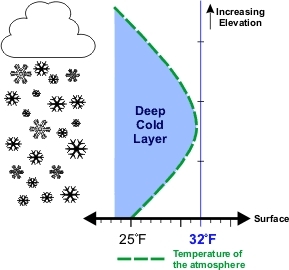Precipitation phenomena (Weather & Climate)

Contents
Precipitation phenomena
Precipitation
In order for precipitation to form, particularly over a large area, several ingredients are necessary. First there must be a source of moisture. The primary moisture sources in the U.S. are the Atlantic and Pacific Oceans as well as the Gulf of Mexico. Winds around high and low pressure systems (a subject of another lesson) transport this moisture inland.
Once the moisture is in place, clouds still need to form. The most effective way to do this is by lifting the air. This can be accomplished by forcing the air up and over mountains or, more commonly, by forcing air to rise near fronts and low pressure areas.
Cloud droplets and/or ice crystals are too small and too light to fall to the ground as precipitation. So there must be a process(es) for the cloud water, or ice, to grow large enough to fall as precipitation. One process is called the collision and coalescence or warm rain process. In this process, collisions occur between cloud droplets of varying size, with their different fall speeds, sticking together or coalescing, forming larger drops.
Learning Lesson: Atmospheric collisions
Finally the drops become too large to be suspended in the air and they fall to the ground as rain. The other process is the ice crystal process. This occurs in colder clouds when both ice crystals and water droplets are present. In this situation it is "easier" for water vapor to deposit directly onto the ice crystals so the ice crystals grow at the expense of the water droplets. The crystals eventually become heavy enough to fall. If it is cold near the surface it may snow, otherwise the snowflakes may melt to rain.
Learning Lesson: Its the "Rain", Man
Take it to the MAX! I'm coocoo for CoCoRaHS
Winter precipitation types and their environments
The vertical distribution of temperature will often determine the type of precipitation (rain vs. snow vs. sleet vs. freezing rain) that occurs at the surface during the wintertime. More often than not, the temperature does not decrease with height but increases, many times by several degrees, before decreasing. This increase, then decrease is called and inversion. In winter, an inversion can be critical in determining the type or types of weather.
| |
In the image (left) the green dashed line is the temperature in respect to elevation. The surface temperature is 25<abbr title="degrees Fahrenheit">°F</abbr> (-4<abbr title="degrees Celsius">°C</abbr>) and increases with height before decreasing. However, since the temperature remains below freezing any precipitation that falls will remain as snow. |
| |
IIn this image the surface temperature is higher, 27°F (-3°C). Also as elevation increases, the temperature increases to a point where some of the atmosphere is above freezing before the temperature lowers again below freezing.
As snow falls into the layer of air where the temperature is above freezing, the snow flakes partially melt. As the precipitation reenters the air that is below freezing, the precipitation will re-freeze into ice pellets that bounce off the ground, commonly called sleet. The most likely place for freezing rain and sleet is to the north of warm fronts. The cause of the wintertime mess is a layer of air above freezing aloft. |
| |
IFreezing rain will occur if the warm layer in the atmosphere is deep with only a shallow layer of below freezing air at the surface. The precipitation can begin as either rain and/or snow but becomes all rain in the warm layer. The rain falls back into the air that is below freezing but since the depth is shallow, the rain does not have time to freeze into sleet.
Upon hitting the ground or objects such as bridges and vehicles, the rain freezes on contact. Some of the most disastrous winter weather storms are due primarily to freezing rain. |
Next: Weather Maps


